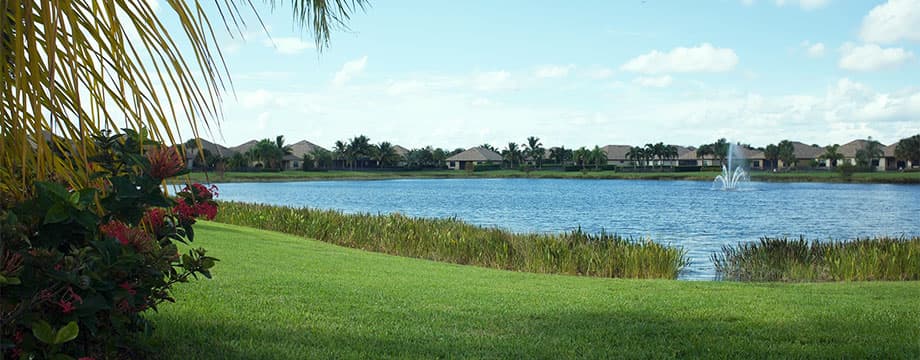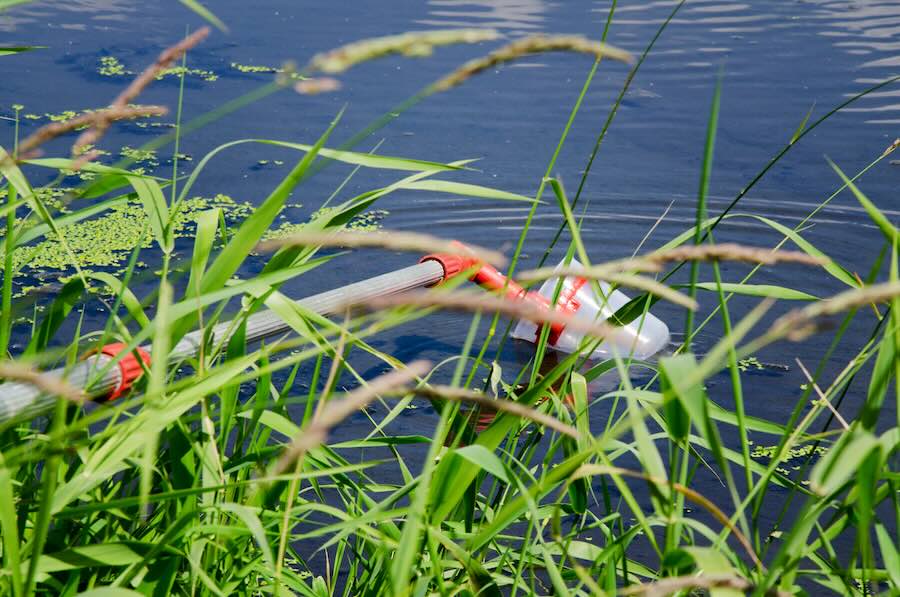If you use a lake to provide the water for your irrigation system then the health of the water in that lake is clearly of vital importance. If you’re relying on irrigation for a location such as a residential community, a golf course, sports or training grounds or a commercial space such as a shopping mall then the lake in question will need to be sizeable and the system you rely upon both extensive and very finely calibrated. Here at Hoover we specialize in designing, engineering and installing systems of just this kind, creating irrigation solutions which can deliver exactly the right amount of water at exactly the right time.

There are numerous reasons why this is vitally important, but the overriding imperative for accurately delivered irrigation is the health of the vegetation being irrigated. which can only be maintained if the system can be relied upon to deliver neither too much nor too little water, and the limitations which are placed on the amount of water any organization can use.
Maximally Effective Irrigation With The Minimum Of Water
In our own state of Florida, limitations will vary both geographically and across different times of the year, but the climate is changing - and the impact this is having on the amount of rain falling in Florida (as in the case of the drought conditions suffered along the Gulf of Mexico coast during 2023), means that any large scale irrigation system needs to be capable of delivering maximally effective irrigation with the minimum of water. To do so, the system will need to operate at or near peak efficiency and any issues with the water being drawn from an irrigation lake are likely to make that impossible. In this article we’ll look at the question of the pH level of the water in an irrigation lake – what it is, how it is measured and what happens if it becomes too high or too low.

The Challenges Of Using A Closed Water Source
We make no secret that irrigation lakes are one of the cornerstones of our philosophy for an effective irrigation system. However, although they can be self-sustaining (their biggest benefit) like all good things, we have to look after them to ensure they are managed with care so they continue to provide good, clean water for landscaping and plants.
Issues such as pH levels impact on closed water sources like irrigation lakes because these are effectively a closed environment, with the body of water constantly facing potential contamination by rain and surface water run-off. Run-off, in particular, is likely to contain a potentially problematic mix of substances derived from urban storm water and agriculture. Left unchecked and unmonitored, substances of this kind can settle as sediment in an irrigation lake and alter the chemical makeup of the water in a way which causes a range of problems for an irrigation system, from blockages in the pipes and sprinklers to contaminated water impacting plant life.
So What Is pH?
The pH level of the water in an irrigation lake is one of the fundamental measures of the health and condition of that water, and, in the simplest terms, is an indicator of the levels of acid and alkali present. While the science behind pH levels can quickly become extremely complicated, what anyone who is in charge of keeping an irrigation lake healthy needs to know is that the measure of pH is set out in a scale, in a similar way to temperature being measured, and that the scale runs from 0 to 14. The lower the pH number of lake water is, the more acid there is present in the water, while a higher number indicates water which is more alkaline. Alkaline water is often referred to as basic water. A pH number of 7 is neutral, which means that the acid and alkaline in the water are in balance, and is the pH number you would expect a sample of completely ‘pure’ water to score.
Bottom line, getting the pH of your irrigation water source right (and keeping it right) is one big step closer to a more healthy landscape.

A Vital Measure Of Lake Health
What needs to be understood by anyone evaluating the pH number of their irrigation lake water is that the pH scale is logarithmic in nature. What this means is that each number below 7, for example, indicates water which is ten times more acidic than the previous number, and the same calculation applies to pH numbers above 7. Anyone monitoring the pH level of their lake needs to avoid making the mistake of thinking that a shift of ‘just’ a couple of numbers either way is nothing to worry about, as the multiplication by a factor of ten each time a new number is hit means that each shift could have a marked impact on the chemical make-up of the water.
pH Levels In Florida
According to figures collated by the University of Florida, the pH level of natural fresh water in Florida, depending upon the local environmental conditions, runs from less than 4.0 to greater than 8.5. In other words, depending upon where in Florida you are and the local conditions pertaining, the water in your irrigation lake could lean toward being naturally acid or naturally alkaline. As we’ve written previously, the lakes used for irrigation in Florida are more likely to struggle with issues of pollution than those anywhere else in the US. The reasons for this are many and complex, from the reclaimed nature of the land in Florida itself to the dense and ever growing population, and while a high or low pH number isn’t in and of itself a matter of pollution, it can act as an early warning for problems further down the line. In particular, the acid or alkaline nature of the water in a lake can impact hugely on the ability of the water to absorb and deal with the substances which enter it in the form of runoff or rain water.

A healthy lake is a self-sustaining organism which maintains levels of oxygen in the water sufficient to support plant and aquatic life. If the cycle of oxygenation breaks down it can have an impact not only on those irrigation lakes (of which there are many examples) which are used for leisure activities and to provide an aesthetically pleasing backdrop, but also on the quality of water being drawn for irrigation purposes. It almost goes without saying that water which has become too acid or alkaline to keep vegetation and marine life safe in the water is not likely to do anything very positive for the soil and vegetation to which it is applied.
Measuring The pH Of Water
It’s possible to check the pH level of the water in your irrigation lake using a simple testing kit and while this may be useful in picking up a sudden shift in the pH number the size of the average irrigation lake means that self-testing can only ever provide the most basic indication. The Florida Department of Transportation, on the other hand, has issued detailed instructions on testing the pH level of water and soil using equipment which includes ‘ a pH/mV meter with automatic temperature compensation (ATC) and a combination electrode that includes a silver/silver chloride reference electrode, a glass bulb indicating electrode, and a thermocouple.
While this may provide a highly accurate measure of pH it does seem like a time-consuming (not to mention expensive) process to undertake in order to determine just the one metric of irrigation water health. Instead, as we suggested in our article on the risks presented by cyanobacteria in irrigation lakes, the monitoring should be carried out through regularly supplying samples of lake water to a specialized laboratory.

In Florida, for example, the UF/IFAS Extension Soil Testing Laboratory (ESTL) in Gainesville can perform analytic tests on water intended for irrigation and/or household usage. The advantage of using a specialized laboratory of this kind is that, as well as providing a measure of pH from just a pint sample of water, the lab can also report on factors such as the hardness of the water, the presence of salt water in what is meant to be a fresh water source and the suspended solids in the water, all of which are invaluable when monitoring lake water for use in a complex irrigation system.
Issues Caused By High Or Low pH
The simplest answer to the question of why pH matters is that if the pH of lake water is too low or too high then the organisms living in that water will die. Most aquatic creatures thrive in water which has a pH range of 6.5 to 9.0. A figure outside of this range can inhibit the ability of organisms within the lake to reproduce. At the same time, a low pH can enable toxic elements carried into the water as runoff to become more mobile in the water and thus more able to be absorbed by plant and aquatic life. From the point of view of irrigation itself, the pH level of the water being used can have an impact on the plant life which is being irrigated. High pH levels, for example, if allowed to build up in the soil itself, can stop the roots of plants absorbing iron and micronutrients, something which can cause the young leaves on plants to turn chlorotic, literally turning yellow as they grow.

Strict Monitoring And Early Action
In addition to the impact it can have on the plants, a high or low pH level can badly damage the irrigation system itself. Water which is too alkaline (i.e. has a high pH) can clog up lines, pipes and injectors with deposits of calcium carbonate, while water which has a pH lower than 6 can be corrosive, damaging metal pipes and fittings. As if the reasons cited above were not enough to prompt strict monitoring of pH levels, it should be borne in mind that algae blooms tend to flourish in water which has a pH between 8.2 and 8.7. Once algae has taken hold, what’s more, it tends to push the pH even level even higher, exacerbating the kind of problems associated with higher pH.
What all of this adds up to is the fact the pH levels of any irrigation lake need to be monitored regularly, preferably as part of a wider monitoring program. Shifts up or down can be caused by a wide range of natural phenomena, from increased plant growth to the presence of algae or even usually heavy rainfall, and so complacency isn’t an option, given the impact that high or low pH can have on your irrigation system and your landscape.







